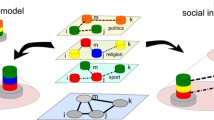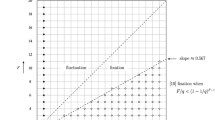Abstract
Axelrod’s model for culture dissemination offers a nontrivial answer to the question of why there is cultural diversity given that people’s beliefs have a tendency to become more similar to each other’s as they interact repeatedly. The answer depends on the two control parameters of the model, namely, the number F of cultural features that characterize each agent, and the number q of traits that each feature can take on, as well as on the size A of the territory or, equivalently, on the number of interacting agents. Here, we investigate the dependence of the number C of distinct coexisting cultures on the area A in Axelrod’s model, the culture–area relationship, through extensive Monte Carlo simulations. We find a non-monotonous culture–area relation, for which the number of cultures decreases when the area grows beyond a certain size, provided that q is smaller than a threshold value q c = q c (F) and F ≥ 3. In the limit of infinite area, this threshold value signals the onset of a discontinuous transition between a globalized regime marked by a uniform culture (C = 1), and a completely polarized regime where all C = q F possible cultures coexist. Otherwise, the culture–area relation exhibits the typical behavior of the species–area relation, i.e., a monotonically increasing curve the slope of which is steep at first and steadily levels off at some maximum diversity value.



Similar content being viewed by others
References
Abrams DM, Strogatz SH (2003) Modeling the dynamics of language death. Nature 424:900
Axelrod R (1997) The dissemination of culture: a model with local convergence and global polarization. J Confl Res 41:203–226
Castellano C, Marsili M, Vespignani A (2000) Nonequilibrium phase transition in a model for social influence. Phys Rev Lett 85:3536–3539
Deffuant G, Neau D, Amblard F, Weisbuch G (2000) Mixing beliefs among interacting agents. Adv Complex Syst 3:87–98
Feller W (1968) An introduction to probability theory and its applications, vol I, 3rd edn. Wiley, New York
Galam S (2002) Minority opinion spreading in random geometry. Eur Phys J B 25:403–406
Goldstone RL, Janssen MA (2005) Trends Cogn Sci 9:424–430
Greig JM (2002) The end of Geography? J Confl Res 46:225–243
He F, Legendre P (1996) On species–area relations. Am Nat 148:719–737
Higgs PG, Derrida B (1991) Stochastic models for species formation in evolving populations. J Phys A 24:L985–L991
Higgs PG, Derrida B (1992) Genetic distance and species formation in evolving populations. J Mol Evol 35:454–465
Kennedy J (1998) Thinking is social. J Confl Res 42:56–76
Klemm K, Eguíluz VM, Toral R, San Miguel M (2003a) Nonequilibrium transitions in complex networks: a model of social interaction. Phys Rev E 67:026120
Klemm K, Eguíluz VM, Toral R, San Miguel M (2003b) Role of dimensionality in Axelrod’s model for the dissemination of culture. Phys A 327:1–5
Klemm K, Eguíluz VM, Toral R, San Miguel M (2003c) Global culture: a noise-induced transition in finite systems. Phys Rev E 67:045101(R)
Laland KN, Brown GR (2006) Niche construction, human behavior, and the adaptive lag hypothesis. Evol Anthropol 15:95–104
Laland KN, Odling-Smee J, Feldman MW (1999) Evolutionary consequences of niche construction and their implications for ecology. Proc Natl Acad Sci USA 96:10242–10247
Lewenstein M, Nowak A, Latané B (1992) Statistical mechanics of social impact. Phys Rev A 45:763–776
Manzo F, Peliti L (1994) Geographic speciation in the Derrida–Higgs model of species formation. J Phys A 27:7079–7086
Nettle D (1998) Explaining Global Patterns of Language Diversity. J Anthropol Archaeol 17:354–374
Nettle D (1999) Linguistic diversity. Oxford University Press, Oxford
Parisi D, Cecconi F, Natale F (2003) Cultural change in spatial environments. J Confl Res 47:163–179
Patriarca M, Leppanen T (2004) Modeling language competition. Phys A 338:296–299
Rosenzweig ML (1995) Species diversity in space and time. Cambridge University Press, Cambridge
Rosenzweig ML, Ziv Y (1999) The echo pattern of species diversity: pattern and processes. Ecography 22:614–628
San Miguel M, Eguíluz VM, Toral R, Klemm K (2005) Binary and multivariate stochastic models of consensus formation. Comput Sci Eng 7:67–73
Schluter D (2000) The ecology of adaptive radiation. Oxford University Press, Oxford
Schulze C, Stauffer D, Wichmann S (2008) Birth, survival and death of languages by Monte Carlo simulation. Commun Comput Phys 3:271–294
Shibanai Y, Yasuno S, Ishiguro I (2001) Effects of global information feedback on diversity. J Confl Res 45:80–96
Singla P, Richardson M (2008) Yes, there is a correlation: -from social networks to personal behavior on the web. In: Proceedings of the 17th International World Wide Web conference. ACM Press, Toronto pp 655–664
Stauffer D, Schulze C (2005) Microscopic and macroscopic simulation of competition between languages. Phys Life Rev 2:89–116
Stauffer D, Schulze C, Rohde K (2007) Habitat width along a latitudinal gradient. Vie Milieu 57:181–187
Sznajd-Weron K, Sznajd J (2000) Opinion evolution in closed community. Int J Mod Phys C 11:1157–1165
Toral R, Tessone CJ (2007) Finite size effects in the dynamics of opinion formation. Commun Comput Phys 2:177–195
Acknowledgements
The work of J.F.F. was supported in part by CNPq and FAPESP, Project No. 04/06156-3. L.A.B. was supported by a FAPESP postdoctoral fellowship.
Author information
Authors and Affiliations
Corresponding author
Rights and permissions
About this article
Cite this article
Barbosa, L.A., Fontanari, J.F. Culture–area relation in Axelrod’s model for culture dissemination. Theory Biosci. 128, 205–210 (2009). https://doi.org/10.1007/s12064-009-0066-z
Received:
Accepted:
Published:
Issue Date:
DOI: https://doi.org/10.1007/s12064-009-0066-z




